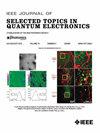Collagen-Related Information Facilitates the Stratification of Breast Cancer Patients With NHG2
IF 5.1
2区 工程技术
Q1 ENGINEERING, ELECTRICAL & ELECTRONIC
IEEE Journal of Selected Topics in Quantum Electronics
Pub Date : 2025-10-14
DOI:10.1109/JSTQE.2025.3621506
引用次数: 0
Abstract
The Nottingham histological grade (NHG) is routinely used to stratify breast cancer patients into NHG1-3 for treatment decisions, yet NHG1/NHG2 ambiguity complicates personalized clinical strategy formulation. In this retrospective study, we included a total of 686 subjects. The NHG1 and 3 tumors (n = 204) in the training cohort (n = 424) were used to construct a tumor-associated collagen signatures-grade model (TACS-grade model) to leverage the difference in the 5-year DFS between NHG1 and NHG3, followed by re-stratifiy NHG2 tumors into TACS-grade 2(TG2)-low and TG2-high subtypes using the learned patterns. Model generalisability was further evaluated in the validation cohort (n = 262). Our results showed that the TG2-high had worse 5-year DFS than the TG2-low, and the 5-year DFS in TG2-high was 56.0% (54.3% in the validation cohort) and 78.8% in the TG2-low (75.0% in the validation cohort) in the training cohort. The 5-year DFS of TG2-low was similar to that of NHG1, while the 5-year DFS of TG2-high was similar to that of NHG3. After integrating the collagen-related information into the NHG system, the modified NHG system (MNHG) demonstrated superior prognostic discrimination. The TACS-grade model re-stratification of NHG2 tumors offers a cost-effective promise for tumor grading and thus may improve the accuracy of clinical decision-making.胶原蛋白相关信息有助于乳腺癌患者NHG2的分层
诺丁汉组织学分级(NHG)通常用于将乳腺癌患者分为NHG1-3进行治疗决策,但NHG1/NHG2的不确定性使个性化临床策略的制定复杂化。在这项回顾性研究中,我们共纳入了686名受试者。训练队列(n = 424)中的NHG1和3肿瘤(n = 204)被用来构建肿瘤相关胶原蛋白特征分级模型(tacs分级模型),以利用NHG1和NHG3之间5年DFS的差异,随后使用学习模式将NHG2肿瘤重新分层为tacs - 2(TG2)低和TG2高亚型。在验证队列(n = 262)中进一步评估模型的通用性。我们的研究结果显示,tg2高组的5年DFS比tg2低组差,训练组tg2高组的5年DFS为56.0%(验证组为54.3%),tg2低组为78.8%(验证组为75.0%)。tg2低的5年DFS与NHG1相似,tg2高的5年DFS与NHG3相似。将胶原蛋白相关信息整合到NHG系统后,改进的NHG系统(MNHG)显示出更好的预后辨别能力。NHG2肿瘤的tacs级模型重新分层为肿瘤分级提供了一种具有成本效益的前景,从而可以提高临床决策的准确性。
本文章由计算机程序翻译,如有差异,请以英文原文为准。
求助全文
约1分钟内获得全文
求助全文
来源期刊

IEEE Journal of Selected Topics in Quantum Electronics
工程技术-工程:电子与电气
CiteScore
10.60
自引率
2.00%
发文量
212
审稿时长
3 months
期刊介绍:
Papers published in the IEEE Journal of Selected Topics in Quantum Electronics fall within the broad field of science and technology of quantum electronics of a device, subsystem, or system-oriented nature. Each issue is devoted to a specific topic within this broad spectrum. Announcements of the topical areas planned for future issues, along with deadlines for receipt of manuscripts, are published in this Journal and in the IEEE Journal of Quantum Electronics. Generally, the scope of manuscripts appropriate to this Journal is the same as that for the IEEE Journal of Quantum Electronics. Manuscripts are published that report original theoretical and/or experimental research results that advance the scientific and technological base of quantum electronics devices, systems, or applications. The Journal is dedicated toward publishing research results that advance the state of the art or add to the understanding of the generation, amplification, modulation, detection, waveguiding, or propagation characteristics of coherent electromagnetic radiation having sub-millimeter and shorter wavelengths. In order to be suitable for publication in this Journal, the content of manuscripts concerned with subject-related research must have a potential impact on advancing the technological base of quantum electronic devices, systems, and/or applications. Potential authors of subject-related research have the responsibility of pointing out this potential impact. System-oriented manuscripts must be concerned with systems that perform a function previously unavailable or that outperform previously established systems that did not use quantum electronic components or concepts. Tutorial and review papers are by invitation only.
 求助内容:
求助内容: 应助结果提醒方式:
应助结果提醒方式:


